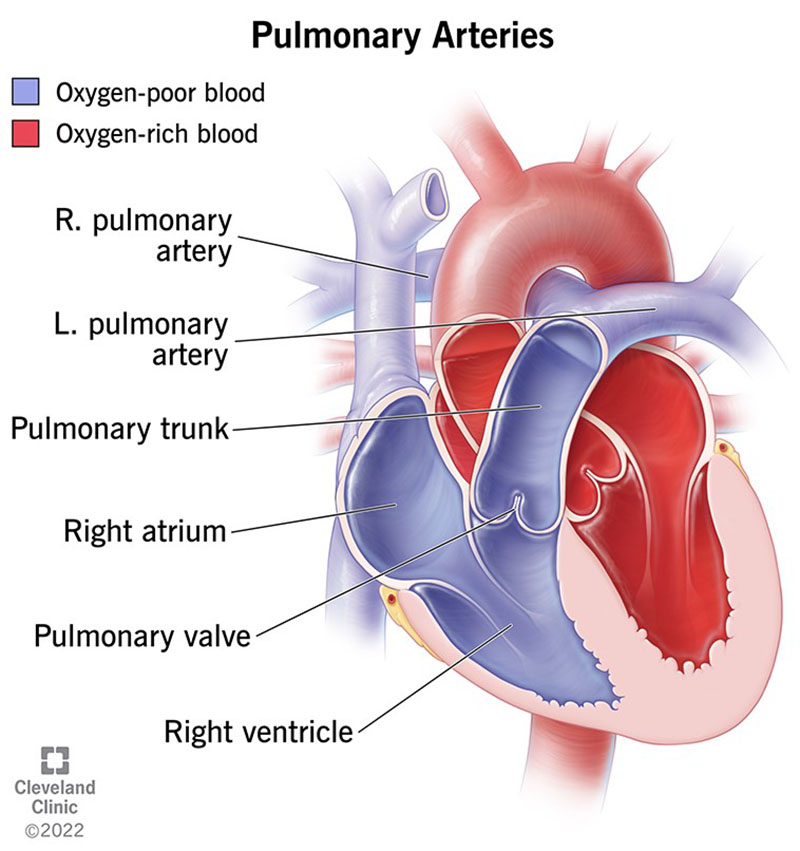Your pulmonary arteries carry blood from your heart to your lungs. They’re the only arteries in your body that carry oxygen-poor (deoxygenated) blood. Your main pulmonary artery (pulmonary trunk) leaves your right ventricle at your pulmonary valve. It soon splits into your right and left pulmonary arteries, which carry blood to each of your lungs.
Advertisement
Cleveland Clinic is a non-profit academic medical center. Advertising on our site helps support our mission. We do not endorse non-Cleveland Clinic products or services. Policy
Your pulmonary arteries are blood vessels that carry oxygen-poor blood from the right side of your heart to your lungs. In medical terms, the word “pulmonary” means something that affects your lungs.
Advertisement
Cleveland Clinic is a non-profit academic medical center. Advertising on our site helps support our mission. We do not endorse non-Cleveland Clinic products or services. Policy
You have one main pulmonary artery, also known as your pulmonary trunk. This artery directly connects with your heart at your pulmonary valve. This is the “door” that controls blood flow out of your lower right heart chamber (right ventricle). After leaving your heart, your main pulmonary artery divides into your right pulmonary artery and left pulmonary artery. Your right and left pulmonary arteries lead to your right lung and left lung, respectively.
You may hear your healthcare provider call your pulmonary artery a “great vessel.” That’s because researchers consider your main pulmonary artery to be one of the great vessels of the heart. Each of these major blood vessels connects with a different chamber of your heart and manages blood flow either in or out of your heart.
Your main pulmonary artery and your aorta are the two great vessels that carry blood out of your heart. A crucial difference is that your pulmonary artery carries oxygen-poor (deoxygenated) blood, while your aorta carries oxygen-rich (oxygenated) blood. In fact, your pulmonary arteries are the only arteries in your body that carry oxygen-poor blood.

Your pulmonary arteries carry oxygen-poor blood from your heart to your lungs.
Advertisement
Your pulmonary arteries carry oxygen-poor blood from your heart to your lungs. This is a vital function. Your blood needs to reach your lungs to gain oxygen and get rid of waste products like carbon dioxide. This blood then returns to your heart, and your heart pumps it out to the rest of your body.
Your pulmonary arteries do important work for your circulatory system. Specifically, they support the part known as your pulmonary circuit. This is the network of blood vessels responsible for sending blood back and forth between your heart and lungs. The many parts of your pulmonary circuit work together as a team to provide oxygen to your blood and remove waste products. Here’s a step-by-step breakdown of that teamwork.
Your pulmonary arteries are located in your chest cavity. Your main pulmonary artery (pulmonary trunk) connects to your right ventricle at your pulmonary valve at the front of the heart. From there, it leaves your heart and travels upward along the left side of your ascending aorta. Beneath your aortic arch, your main pulmonary artery splits into the right pulmonary artery and left pulmonary artery. These arteries then travel to each of your lungs.
Your main pulmonary artery is usually around 5 centimeters (cm) long. Its average diameter is 2.7 cm in females and 2.9 cm in males.
Like other large and medium-sized arteries, the walls of your pulmonary arteries are made of three layers:
The most common problems that affect the pulmonary arteries are congenital heart defects. These issues are present at birth.
Congenital heart conditions that may affect your pulmonary arteries include:
Advertisement
Conditions that can affect adults’ pulmonary arteries include:
Many conditions that affect your pulmonary arteries are present at birth. While you can’t prevent congenital diseases, there are other diseases that you should manage well to prevent the development of pulmonary hypertension. These include:
In addition, you can take the following actions to support your heart health:
Call your healthcare provider if you experience:
Advertisement
Your pulmonary arteries carry oxygen-poor blood from your heart to your lungs. They’re a vital part of your circulatory system. But because you can’t see them, it can be easy to forget they’re working hard every day.
That’s why it’s helpful to learn your pulmonary artery anatomy along with the lifestyle changes you can make to support your heart and blood vessels. Learning how your body works can help make the invisible become visible. Ask your healthcare provider what you can do to keep your pulmonary arteries and circulatory system healthy.
Advertisement
When your heart needs some help, the cardiology experts at Cleveland Clinic are here for you. We diagnose and treat the full spectrum of cardiovascular diseases.

Last reviewed on 10/29/2022.
Learn more about the Health Library and our editorial process.